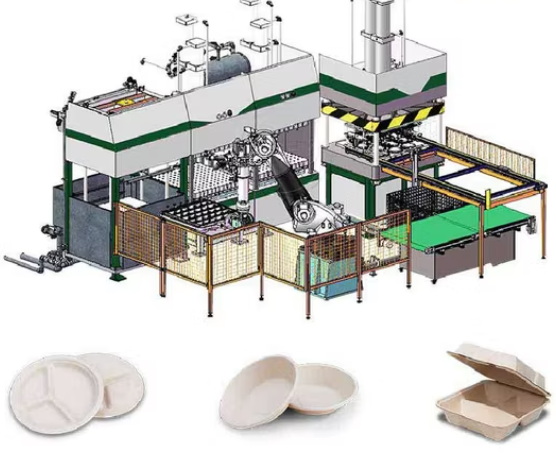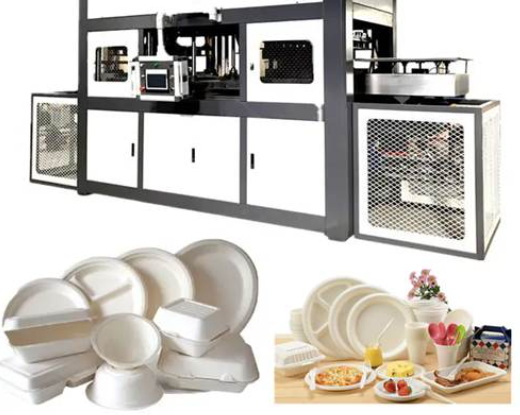
Content Menu
● Introduction to Eco Friendly Disposable Plate Making Machines
>> Key Features of Eco Friendly Disposable Plate Making Machines
● How Eco Friendly Disposable Plate Making Machines Work
>> 1. Pulping
>> 2. Molding
>> 3. Drying
>> 4. Post-processing
● Benefits of Eco Friendly Disposable Plate Making Machines
>> Environmental Impact
>> Economic Benefits
>> Health and Safety
● Applications of Eco Friendly Disposable Plate Making Machines
● Types of Eco Friendly Disposable Plate Making Machines
● Manufacturers and Suppliers
● Market Trends and Future Outlook
● Conclusion
● FAQ
>> 1. What materials are used in eco friendly disposable plate making machines?
>> 2. How do eco friendly disposable plate making machines reduce environmental impact?
>> 3. What are the economic benefits of using eco friendly disposable plate making machines?
>> 4. How do eco friendly disposable plates compare to traditional plastic plates in terms of health and safety?
>> 5. What types of industries use eco friendly disposable plate making machines?
In recent years, the world has witnessed a significant shift towards sustainability, with a growing emphasis on reducing plastic waste and promoting eco-friendly alternatives. One of the key innovations in this area is the eco friendly disposable plate making machine, designed to produce biodegradable and compostable plates from natural materials. These machines are revolutionizing the tableware industry by offering a sustainable alternative to traditional plastic plates.

Introduction to Eco Friendly Disposable Plate Making Machines
Eco friendly disposable plate making machines are designed to manufacture plates from biodegradable materials such as sugarcane bagasse, wheat straw, and bamboo pulp. These machines are fully automated, integrating processes like pulping, molding, drying, and hot pressing to produce high-quality, eco-friendly plates. The automation ensures efficiency and consistency in production, making them ideal for large-scale manufacturing.
Key Features of Eco Friendly Disposable Plate Making Machines
1. Material Variety: These machines can use various biodegradable materials, ensuring flexibility in production based on available resources. This feature allows manufacturers to adapt to different regional materials, reducing transportation costs and supporting local economies.
2. Automation: Fully automated processes reduce labor costs and increase production efficiency. This automation also ensures that the plates are produced under consistent conditions, maintaining quality standards.
3. Environmental Benefits: The use of renewable resources and biodegradable materials significantly reduces plastic pollution and conserves non-renewable resources. This shift towards sustainable materials helps in mitigating environmental issues such as plastic waste accumulation in oceans and landfills.
4. Customization: Machines can be customized to produce plates of different sizes and shapes, meeting specific market demands. This flexibility allows businesses to cater to a wide range of customers, from small gatherings to large events.
How Eco Friendly Disposable Plate Making Machines Work
The process of making biodegradable plates involves several stages:
1. Pulping
Raw materials are crushed and pulped to create a uniform pulp. This process breaks down the fiber structure, allowing for even distribution in the mold. The pulping stage is crucial as it determines the strength and texture of the final product.
2. Molding
The pulp is injected into a mold where it is subjected to pressure, causing the fibers to intertwine and form a wet blank. The molding process requires precise control over temperature and pressure to ensure that the plate forms correctly.
3. Drying
The wet blank is dried using hot air or electric heating to remove excess moisture and solidify the fibers. This stage is critical for preventing mold growth and ensuring the plate remains stable.
4. Post-processing
The semi-finished plates are trimmed, polished, and may have a waterproof layer applied to enhance durability and appearance. This final step prepares the plates for use in various settings, from casual gatherings to formal events.
Benefits of Eco Friendly Disposable Plate Making Machines
Environmental Impact
- Reduced Plastic Pollution: Biodegradable plates decompose faster than plastic, reducing landfill waste and pollution. This reduction in plastic waste contributes significantly to cleaner environments and healthier ecosystems.
- Conservation of Resources: Uses renewable resources, reducing reliance on non-renewable petroleum-based materials. This shift helps in conserving fossil fuels and reducing carbon emissions associated with their extraction and processing.
Economic Benefits
- Cost-Effective Production: Automated processes reduce labor costs and increase efficiency. This efficiency allows businesses to produce more plates at a lower cost, making them more competitive in the market.
- Market Demand: Growing demand for eco-friendly products provides a lucrative market opportunity. As consumers become more environmentally conscious, businesses that adopt eco-friendly practices are likely to attract more customers and enjoy higher brand loyalty.
Health and Safety
- Chemical-Free: Biodegradable plates are free from harmful chemicals found in some plastic plates. This makes them safer for food contact, reducing the risk of chemical contamination.
- Hygiene: Disposable plates eliminate the risk of cross-contamination. This is particularly important in settings where food safety is paramount, such as restaurants and hospitals.

Applications of Eco Friendly Disposable Plate Making Machines
These machines are widely used in:
- Food Service Industry: Fast-food chains, restaurants, and catering services benefit from the convenience and sustainability of biodegradable plates.
- Event Planning: Weddings, parties, and exhibitions often use disposable plates for convenience and to reduce cleanup efforts.
- Packaging Industry: For food or small product packaging, biodegradable plates offer an eco-friendly alternative to traditional plastic packaging materials.
Types of Eco Friendly Disposable Plate Making Machines
1. Semi-automatic Machines: Require manual intervention during production. These machines are suitable for small-scale operations or where labor costs are low.
2. Fully Automatic Machines: Entirely automated, reducing labor needs. These machines are ideal for large-scale production where efficiency and consistency are crucial.
3. Robotic Machines: Advanced automation with robotic arms for efficient handling. These machines offer the highest level of automation and are used in high-volume production facilities.
Manufacturers and Suppliers
Several companies specialize in manufacturing eco friendly disposable plate making machines. These companies offer a range of models with varying capacities and features to suit different production needs. When selecting a machine, businesses should consider factors such as production volume, available resources, and market demand.
Market Trends and Future Outlook
The market for eco-friendly disposable plates is expected to grow significantly as governments and consumers increasingly prioritize sustainability. Regulations limiting the use of single-use plastics are driving demand for biodegradable alternatives. Businesses investing in eco friendly disposable plate making machines are well-positioned to capitalize on this trend and contribute to a more sustainable future.
Conclusion
Eco friendly disposable plate making machines are a significant step towards reducing plastic waste and promoting sustainability. By utilizing renewable resources and biodegradable materials, these machines offer a cost-effective and environmentally friendly solution for the tableware industry. As demand for eco-friendly products continues to grow, investing in these machines can provide businesses with a competitive edge while contributing to a cleaner environment.

FAQ
1. What materials are used in eco friendly disposable plate making machines?
Eco friendly disposable plate making machines primarily use biodegradable materials such as sugarcane bagasse, wheat straw, bamboo pulp, and wood pulp.
2. How do eco friendly disposable plate making machines reduce environmental impact?
These machines reduce environmental impact by using renewable resources, minimizing plastic waste, and producing biodegradable products that decompose naturally.
3. What are the economic benefits of using eco friendly disposable plate making machines?
The economic benefits include reduced labor costs due to automation, lower production costs, and access to a growing market for eco-friendly products.
4. How do eco friendly disposable plates compare to traditional plastic plates in terms of health and safety?
Eco friendly disposable plates are generally safer as they are free from harmful chemicals found in some plastic plates and eliminate the risk of cross-contamination.
5. What types of industries use eco friendly disposable plate making machines?
These machines are used in the food service industry, event planning, packaging industry, and retail sectors.

















